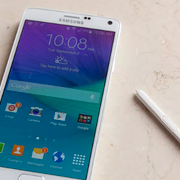
Oroligt näringsliv bromsar Sydkoreas tillväxt
Samsungs fiasko med flaggskeppstelefonen Galaxy Note 7, en stor strejk på biltillverkaren Huyundai och rederijätten Hanjins konkurs. Det är några av de hårdaste slagen mot Sydkoreas näringsliv den senaste tiden. Nu sätter de spår i tillväxten. Förra kvartalet sänktes BNP-tillväxten på årsbasis till med 0,6 procentenheter till 2,7 procent.
bakgrund
Sydkoreas ekonomi
Wikipedia (en)
The economy of South Korea is the fourth largest economy in Asia and the 11th largest in the world. It is a mixed economy dominated by family-owned conglomerates called chaebols, however, the dominance of chaebol is unlikely and at risk to support the transformation of Korean economy for the future generations. South Korea is famous for its spectacular rise from one of the poorest countries in the world to a developed, high-income country in just one generation. This economic miracle, commonly known as the Miracle on the Han River, brought South Korea to the ranks of elite countries in the OECD and the G-20. South Korea still remains one of the fastest growing developed countries in the world following the Great Recession. It is included in the group of Next Eleven countries that will dominate the global economy in the middle of the 21st century.
By creating favorable policy directive for economic development as preceded by Japanese economic recovery as the logistic supplying bastion for American troops in the Korean peninsula during and after the Korean War, South Korea's rigorous education system and the establishment of a highly motivated and educated populace is largely responsible for spurring the country's high technology boom and rapid economic development. Having almost no natural resources and always suffering from overpopulation in its small territory, which deterred continued population growth and the formation of a large internal consumer market, South Korea adapted an export-oriented economic strategy to fuel its economy, and in 2014, South Korea was the seventh largest exporter and seventh largest importer in the world. Bank of Korea and Korea Development Institute periodically release major economic indicators and economic trends of the economy of South Korea.
In the 1997 Asian financial crisis, the South Korean economy suffered a liquidity crisis and relied on the bailout by the IMF that restructured and modernized the South Korean economy with successive DJnomics policy by President Kim Dae Jung, including the resultant of the national development of the ICT industry. Historically, subsidies were used as means of speeding up adoption of new technology in Korea and has ultimately helped the adoption and development of faster mobile standards for the economy of South Korea. The growth of ICT industry has been far concentrated on the hardware sector, which focuses on expanding wired and wireless telecommunication network penetration rather than the software sector, which creates innovative applications and value-added services. The economy of South Korea is the global leader of Consumer electronics, Mobile Broadband and Smartphone. South Korea's LCD TV global market share also jumped to 37 percent in 2009, from 27 percent at the end of 2007, and it will soon replace Japan as the world’s number-one LCD-TV supplier. The economy of South Korea ranks No.1 in the world in ICT Development Index 2015 and 2015 Bloomberg Innovation Index.
Despite the South Korean economy's high growth potential and apparent structural stability, South Korea suffers perpetual damage to its credit rating in the stock market due to the belligerence of North Korea in times of deep military crises, which has an adverse effect on the financial markets of the South Korean economy. However, renowned financial organizations, such as the International Monetary Fund, also compliment the resilience of the South Korean economy against various economic crises, citing low state debt, and high fiscal reserves that can quickly be mobilized to address any expected financial emergencies. Other financial organizations like the World Bank describe Korea as one of the fastest-growing major economies of the next generation along with BRIC and Indonesia. South Korea was one of the few developed countries that was able to avoid a recession during the global financial crisis, and its economic growth rate will reach 6.1% in 2010, a sharp recovery from economic growth rates of 2.3% in 2008 and 0.2% in 2009 when the global financial crisis hit. The South Korean economy again recovered with the record-surplus of US$70.7 billion mark of the current account in the end of 2013, up 47 percent growth from 2012, amid uncertainties of the global economic turmoil, with major economic output being the technology products exports.
South Korea was a historical recipient of official development assistance (ODA) from OECD. Throughout the 1980s until the mid-1990s, South Korea's economic prosperity as measured in GDP by PPP per capita was still only a fraction of industrialized nations. In 1980, the South Korean GDP per capita was $2,300, about one-third of nearby developed Asian economies such as Singapore, Hong Kong, and Japan. Since then, South Korea has advanced into a developed economy to eventually attain a GDP per capita of $30,000 in 2010, almost thirteen times the figure thirty years ago. The whole country's GDP increased from $88 billion to $1,460 billion in the same time frame. In 2009, South Korea officially became the first major recipient of ODA to have ascended to the status of a major donor of ODA. Between 2008 and 2009, South Korea donated economic aid of $1.7 billion to countries other than North Korea. South Korea's separate annual economic aid to North Korea has historically been more than twice its ODA.
On June 23, 2012, South Korea is landmarked to become the 7th member of the 20-50 club (with the population surpassing 50 million and maintaining per capita income of US$20,000), chronologically, after Japan, United States of America, France, Italy, Germany and United Kingdom. A free trade agreement between the United States of America and the Republic of Korea was concluded on April 1, 2007. The European Union–South Korea Free Trade Agreement was signed on 15 October 2009. The South Korean economy is heavily dependent on the energy imports and the related refinery technologies in association with the Ministry of Knowledge Economy and in accordance with the South Korea-Australia Free Trade Agreement. The Canada–South Korea Free Trade Agreement was concluded in 2014. China–South Korea Free Trade Agreement went official on November 10, 2014. South Korea has the largest indoor Amusement park in the world, Lotte World, adding to the notable export-oriented music industry guided by the Ministry of Culture, Sports and Tourism of the Republic of Korea (for more, see Korea K-Pop Hot 100).
Omni är politiskt obundna och oberoende. Vi strävar efter att ge fler perspektiv på nyheterna. Har du frågor eller synpunkter kring vår rapportering? Kontakta redaktionen



